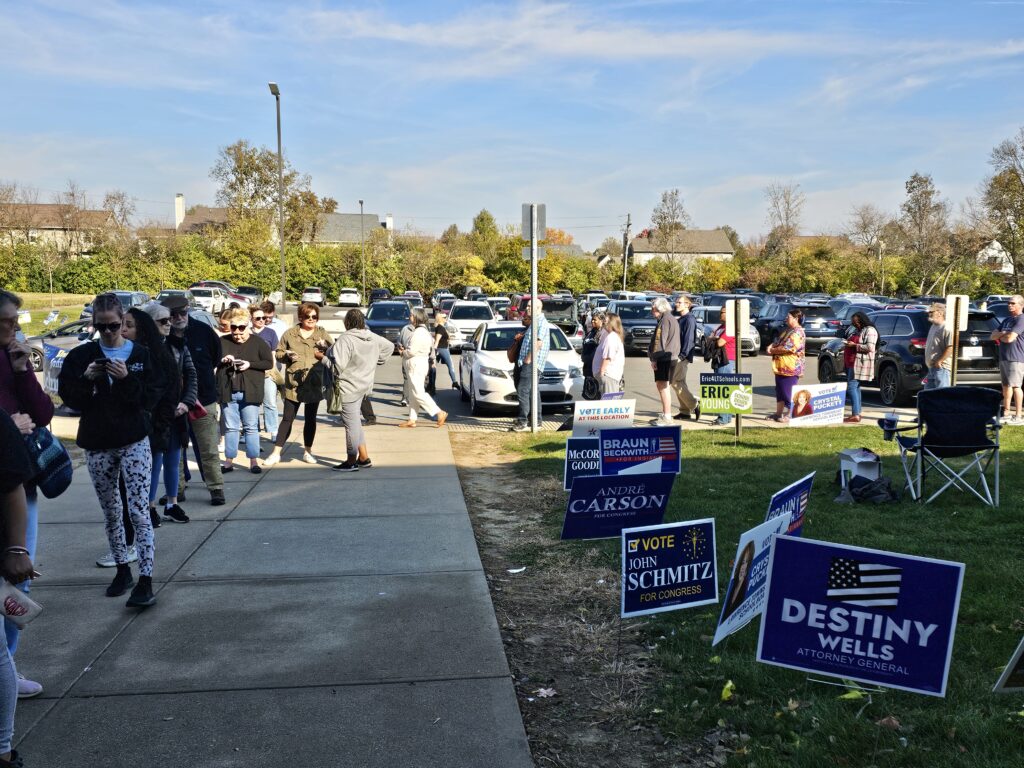
Voters line up outside of the MSD Lawrence Education & Community Center at lunchtime on Oct. 30, 2024. (Submitted by Brad Klopfenstein)
There is no substitute for just showing up. Sometimes I wish there was one, but there just isn’t.
The relentless polling that exhausted Americans during the last three months of the presidential campaigns never really swung all that much, no matter what the drama of the day was. By the time Labor Day arrived, the persuasion part of the national campaign was largely over.
I was skeptical of every undecided voter this year. The presidential choices were so stark, remaining voter indecisiveness was really about whether they would vote at all, not whether they would choose Harris or Trump.
About nine million fewer Americans voted for president this year than in 2020, according to unofficial results as several states are still counting. Based on the estimated adult population in the country of 271 million, that means about 54% of eligible voters participated in the presidential election. That is down from 60% in 2020 but is an identical participation rate to 2016.
The old adage that Democrats perform better when turnout is better rings true again this year. I believe the adage is true on a macro level, and the swings over the last three elections confirm that. But 2020 was a year like no other, so that likely deserves an asterisk more than a medal.
It is difficult for a civic-minded person like me to accept that nearly half of Americans aren’t participating in their inherited gift of self-governance. It is truly a gift. And when I say, “it is difficult” to accept these shameful participation rates, I am editing out the necessary profanity while speaking through grinding teeth. What is truly difficult to me, is forgiving those who don’t show up for this most basic civic duty.
That’s America. And that data is maddening in and of itself. But then there’s Indiana.
Hoosier data
Early voting lines seemed to be a good harbinger but didn’t last.
Democrats have plenty of things keeping them from competing well here, but no aspect is more important than participation. I’ve written it many times before that the party needs a movement to reestablish its relevance. And movements require attendance.
So, where should the party look for the catalyst to achieve better participation? Always start at the top. In Indiana, the top is Indianapolis Mayor Joe Hogsett. He is the highest ranking Democrat in the state, and he represents the largest number of Democrat voters. Right next to Hogsett sits Indianapolis Rep. Andre Carson, who was actually on the ballot this year. Neither are even trying to get voters to the polls. Their shared apathy matches the city’s numbers.
Hayleigh Columbo reported for the Indianapolis Star last month, “There were more than 4.8 million registered voters in Indiana as of this year’s Oct. 7 registration deadline, according to the Indiana Secretary of State’s office…Comparatively, 4.75 million Hoosiers were registered to vote ahead of the 2020 election.” Indiana ranked 39th in the nation in 2020 and dropped to 40th this year.
That’s specific to registrations though, which is a subset of participation.
Around 2.799 million Hoosiers voted for governor this year, down from 3,020,000 in 2020. But the population has also grown slightly. Therefore, the participation rate reduction is even larger than the “turnout” reduction here.
Turnout stats aren’t yet finalized for Indiana — 24 counties had not yet reported — but the average so far is 55%. That is much lower than the 65% for 2020 and even the 58% in 2016.
Nowhere is the participation rate more embarrassing in Indiana than in Marion County.
According to World Population Review, there are 732,685 adults in Marion County. Approximately 350,000 people voted here. So, when the Indianapolis Star reports that the turnout rate in Indianapolis is 53.8%, the participation rate is worse, at 47.8%.
That’s right, less than half of the adults living in the state’s capital city vote. To me, this is baffling. I can’t imagine that voting is easier anywhere in Indiana than in Indianapolis, yet the city is not in the same universe as, say, Hamilton County, directly to the north.
A little over 70% of registered voters showed up in Hamilton County this year, and that turnout percentage is also a slight decline from previous years. Oh, to be as bad as suburbia!
Indiana’s voter turnout is worst in its most urban counties, and best in its suburban. That seems to track with national trends. Why? I don’t have a definitive answer, but as you might guess, I certainly have advice.
Campaigns have two primary missions. First, to persuade voters that the candidate is the best one. Second, to inspire voters who agree to participate.
It’s tiresome to listen to pundits say that Indiana Democrats need to move right if they want to win. Democrats aren’t even showing up well enough to conclude such a thing.
And a funny thing happens when people do show up. They become aware of what is possible. Indiana ranks so poorly in so many ways, the story advocating for the status quo is a hard sell.
It does, however, sell well in a half empty room.
GET THE MORNING HEADLINES.

